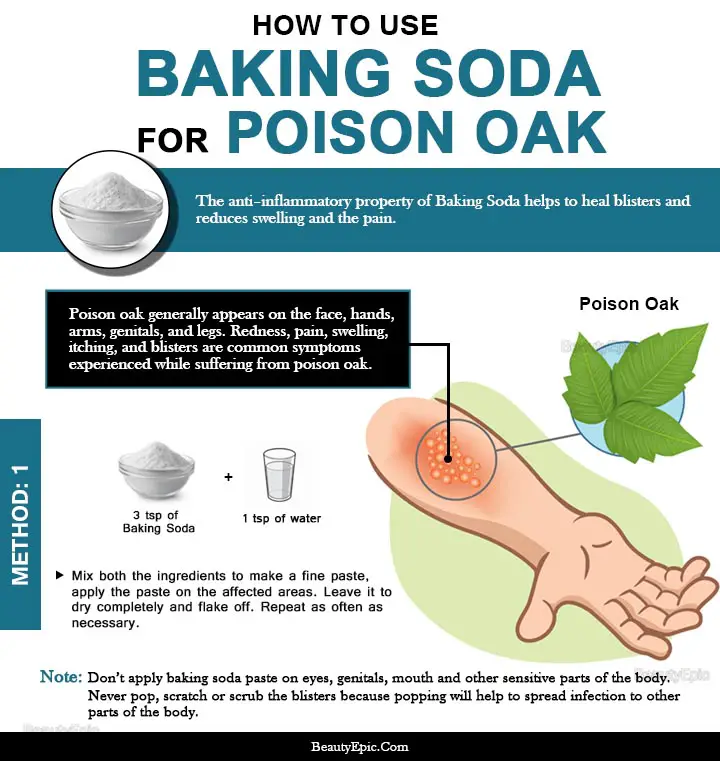
Important: This article is for informational purposes only. Please read our full disclaimer for more details.
Approximately half of the Americans experience allergic reactions from poison oak plant, which is found in different parts of America. Poison oak, a leafy shrub, releases urushiol, which causes rashes. According to Mayo Clinic, the symptoms of poison ivy rash include itching, redness, blisters and swelling. Do you know what the home remedy is for treating the poison oak rashes? Here in this article we will discuss how to use with one kitchen ingredient, baking soda for poison oak.
Is Baking Soda Really Effective for Poison Oak?
Yup, baking soda is the cost-effective natural remedy for treating poison oak rashes. Baking soda acts as an acid neutralizer, which neutralizes the acid in urushiol. The other name of baking soda is sodium carbonate and with its sodium, baking soda pulls off toxins from blisters thus making the blisters dry. In addition, it prevents itching and thus spread of infection.
Moreover, baking soda appears to tell the body to calm down its autoimmune response. Instead, it helps to strengthen the anti-inflammatory response. Besides, oral NaHCO3 intake stimulates splenic anti-inflammatory pathways (1).
How to use Baking Soda for Poison Oak
How Does Baking Soda Treat Poison Oak Rashes?

The anti–inflammatory property of baking soda helps to heal blisters and reduces swelling and the pain. There are different ways of using baking soda for treating poison oak rashes.
1. Baking Soda and Water for Treating Poison Oak Rashes
The paste of baking soda and water speeds up the recovery from poison oak rashes. It removes the blisters caused by poison oak plant.
Ingredients:
- 3 teaspoons of baking soda
- 1 teaspoon of water
Preparation time: 5 minutes.
Procedure:
- Make a paste of baking soda and water
- Apply it to rashes.
- For few minutes, leave it to dry
How it works: when baking soda is mixed with water and it is applied to the affected areas, it works like a magic. It helps to recover from poison oak rashes.
Repetitions: 3-4 times daily.
Best time to apply: morning, noon, afternoon, night.
[ Read: How to Use Baking Soda for Rashes ]
2. Vinegar and Baking Soda for Treating Poison Oaks Rashes
The paste of baking soda with vinegar speeds up the recovery from poison oak rashes. It prevents the affected areas from itching and irritation.
A study conducted on anti-bacterial, anti-fungal, and anti-inflammatory activities of wood vinegar revealed that it is a potential remedy for major plant diseases and inflammatory reactions (2). Therefore, using baking soda along with vinegar can speed up the process.
Ingredients:
- 3 teaspoons of baking soda
- 1 ½ teaspoon of white vinegar or apple cider vinegar
Preparation time: 5 minutes.
Procedure:
- Make a thick paste of baking soda and vinegar
- Apply it to the affected areas
- Massage the area gently for few minutes
- Rinse with water
How it works: when baking soda is mixed with vinegar and applied on rashes, then it gives relief to the affected person. It prevents irritation, itching.
Repetitions: daily.
Best time to apply: before bath.
Tips: bear in mind, when vinegar is applied, it may cause burning sensation. Don’t worry; this sensation will be reduced in some time.
Common vinegars are weak acids that contain 4 to 8 percent acetic acid, which can erode the skin and cause significant chemical burns, especially when applied under occlusion (3).
Words of Caution
Even though baking soda is effective in reducing the rashes and other side effects of poison oak, it should be used cautiously to counteract side effects. You need to follow the below points while using baking soda-
- Don’t apply baking soda paste on eyes, genitals, mouth and other sensitive parts of the body.
- Never pop, scratch or scrub the blisters because popping will help to spread infection to other parts of the body.
If you learn to identify the poisonous plant, you will be able to avoid getting into contact with them. Even inhaling the smoke of this plant may cause rashes on skin.
You Might Also Like:
- 14 Surprising Beauty Benefits of Baking Soda You Must Know!
- Baking Soda Bath: Benefits and How to Do?
- Top 11 Homemade Baking Soda Face Mask Recipes and Benefits
- Homemade Baking Soda Facial Scrub Recipes for Gorgeous Face & Skin
- How to Use Baking Soda for Bad Breath?
- How to Use Baking Soda for Constipation Relief?
- How to Remove Dandruff With Baking Soda?
- Baking Soda for Razor Bumps – Benefits, Uses and Precautions
- How to Use Baking Soda for Stretch Marks?
- How to Whiten Teeth with Baking Soda
- How to Remove Stretch Marks with Baking Soda
- How to Cure an Upset Stomach with Baking Soda?
- How To Treat Skin Rash with Apple Cider Vinegar
Image:- 1















